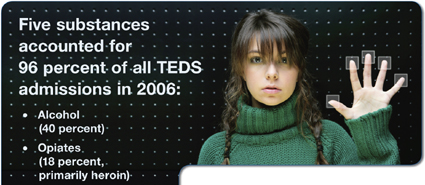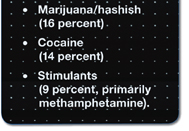New Data on Treatment Admissions
Alcohol Abuse Highest, but Methamphetamine, Marijuana,
Prescription Painkillers on the Rise
Problems with alcohol as a primary
substance of abuse accounted for
40 percent of the 1.8 million admissions in 2006
for substance abuse treatment in the United States.
The latest SAMHSA report, Treatment
Episode Data Set (TEDS) Highlights—2006: National
Admissions to Substance Abuse Treatment
Services, presents details
of the demographic and substance abuse characteristics
of these admissions for alcohol or drug abuse treatment.
2006 Highlights
Five substances accounted for 96 percent of all TEDS
admissions in 2006: alcohol (40 percent); opiates (18
percent, primarily heroin); marijuana/hashish (16 percent);
cocaine (14 percent); and stimulants (9 percent, primarily
methamphetamine). Of primary alcohol admissions, 45
percent reported secondary drug abuse as well.
 |
 |
Although
the largest share of treatment admissions
is still for alcohol, this percentage
is markedly lower than the 51-percent
share of admissions for alcohol abuse
treatment in 1996. The TEDS 2006
report also reveals that, over the
same 10-year period, the percentages
of admissions for |
| abuse
of methamphetamine, prescription
painkillers, and marijuana increased. |
Although the percentage of admissions for primary heroin
abuse is at about the same level it was
a decade ago (14 percent), the percentage of treatment
admissions for other opiates—mainly misused prescription
painkillers—increased from 1 percent in 1996 to
4 percent in 2006.
The proportion of admissions for primary marijuana
abuse increased from 12 percent in 1996 to 16 percent
in 2006. The average age of those admitted for marijuana
treatment was significantly younger (age 24) than the
average age for all substance abuse treatment admissions
(age 34).
Smoked cocaine (crack) represented 71 percent of all
primary cocaine admissions in 2006. Among non-smoked
cocaine admissions, 80 percent reported inhalation as
the route of administration, 11 percent reported injection,
and 7 percent reported oral.
Although relatively small, the percentage of treatment
admissions primarily due to methamphetamine/amphetamine
abuse nearly tripled from 3 percent in 1996 to 9 percent
in 2006.
Back
to Top
Referrals
The criminal justice system was the principal source
of referral for 55 percent of all the
treatment admissions for methamphetamine/ amphetamine
abuse. Of TEDS admissions in 2006, 63 percent entered
ambulatory treatment, 20 percent entered detoxification,
and 17 percent entered residential/rehabilitation treatment.
The TEDS 2006 report is the latest in a series of yearly
reports providing demographic and other information
on substance abuse treatment admissions from state-licensed
treatment facilities (most of them publicly funded).
The report does not include information on all treatment
admissions. However, TEDS is the largest, most comprehensive
study of
its kind in the United States.
The TEDS report is available on the SAMHSA Web site
at http://oas.samhsa.gov/teds2k6highlights/TOC.cfm,
or by calling SAMHSA’s Health Information Network
at 1-877-SAMHSA-7 (1-877-726-4727). Ask for publication
number SMA08-4313. 
Back
to Top
« Previous
Article
Next
Article »
Back
to Top
|



